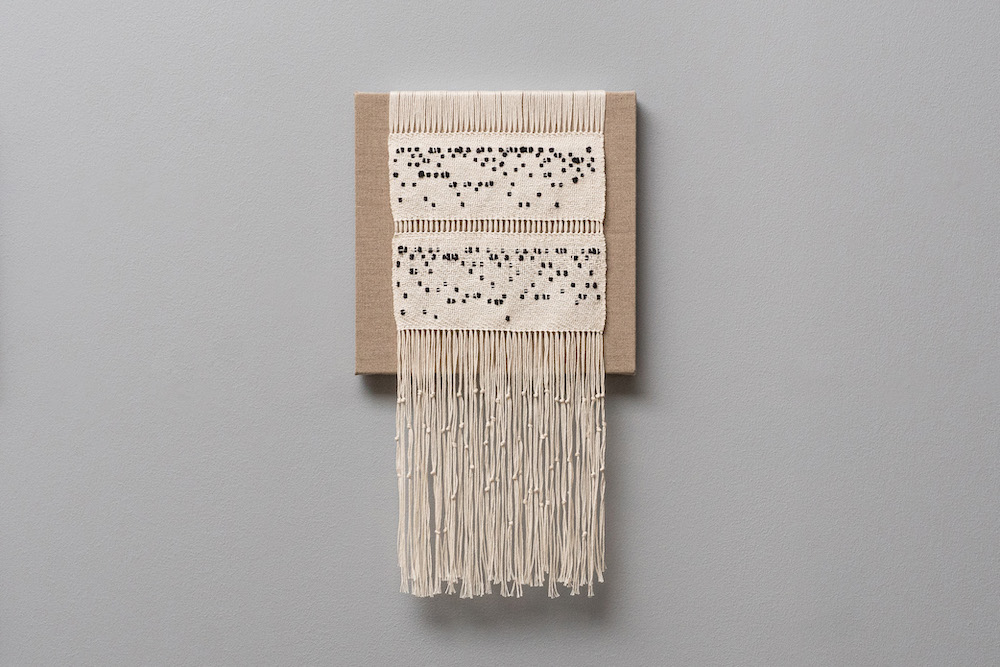Multidisciplinary Los Angeles–based artist Ahree Lee started her career focused on video work. In 2001, she took on her first major long-term project employing the repetitive and somewhat pedestrian habit of taking a daily selfie. The resulting images were transformed into a mesmerizing visual diary, Me, 2001, which became a prescient viral YouTube sensation. Envisioned as a lifetime effort, it inspired a tsunami of imitators and was arguably one of the internet’s first time-lapse self-portrait videos.
The video works were a precursor to her parallel passion—weaving. At one point she had a stint in tech, which, notably, is connected to that ancient tradition. Indeed, early computers mimicked the processes that enabled weaving looms—a clever application of a straightforward process. “Weaving is binary, either a warp or a weft thread is, on the surface, essentially a zero or one,” says Lee, the daughter of Korean immigrants, who graduated with an MFA from Yale.
The history of women as essential protagonists in the tech field is often overlooked. “Women were instrumental in writing the first computer programs and filling the ranks of programming jobs in the early years,” Lee notes. One of her works, Ada (2019), composed of cotton, linen and wool, is a homage to Ada Lovelace, who wrote the first computer program in the 19th century. The hand-wrought work mimics 1960s-era IBM punch cards, with black yarn marking spots corresponding to perforated holes. Yet women’s roles have dimmed over time as men populated the field and “bro culture” took hold. Despite the industry’s recent outward public relations proclamations and media exposés, tech culture has become, if anything, increasingly clamorous: witness theZuckerberg-Musk wrestling hype.

Ahree Lee, Motherboard Study, 2021. Courtesy of the artist.
With Pattern: Code (2019), the result of a residency at the Women’s Center for Creative Work, Lee explored connections between technology, craft and the value of women’s labor—elegantly simple, if conceptually rigorous, correlations. One particularly personal work—Timesheet: November 4–10 (2018)—is a carefully rendered and revelatory tapestry, recording time spent on personal tasks with highlighted threads tracking
activities such as sleep, childcare and work. More recently, the ongoing series she started in 2021, “Motherboard,” juxtaposes the functional and aesthetic qualities of Bauhaus weavings and computer motherboards. The women of the prominent Bauhaus school were “assigned” to the weaving workshop. These included such figures as Anni Albers and Margarete Köhler-Bittkow. Despite being relegated to a lower status—and counter to Modernist limitations—they developed several expressionistic innovations, such as soundproofing, and incorporating cellophane and light-reflective fabrics into their processes. Lee’s adept conceptual synthesis renders unique perspectives on the roles that power and gender play in buried historical narratives—without a shred of mawkishness.
Up next is a solo exhibition at California State University Long Beach in 2024. While most of her work to date has focused on what she admits are
explorations of emotionally fraught reflections of familial and gender roles, Lee seeks to consolidate technology, domestic activity and multimedia into a kind of alternative frame of thinking, inviting social action where “women weave computer code and men stitch circuits.” It’s true enough that we exist in an ever-accelerating and unwieldy loop of information exchange between humans, technology and, increasingly, AI, with its relentless focus on efficiency. It seems opportune to propose a social road map for something better.











0 Comments